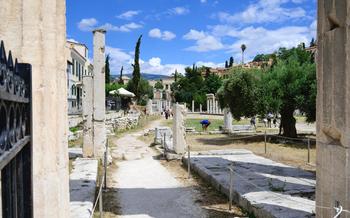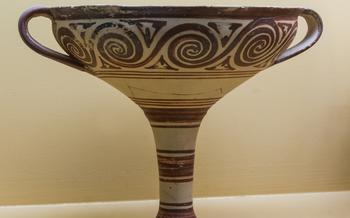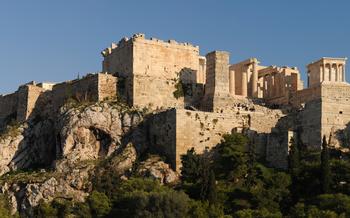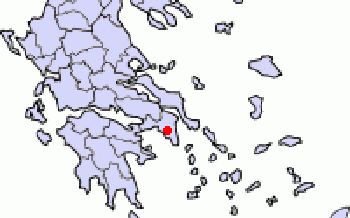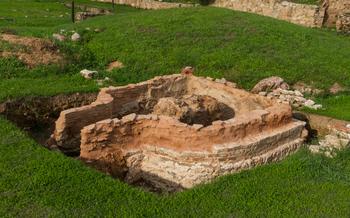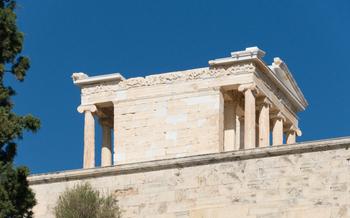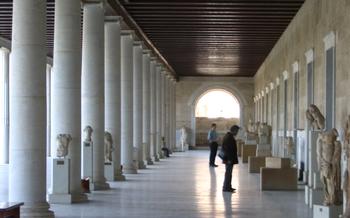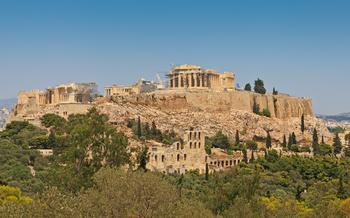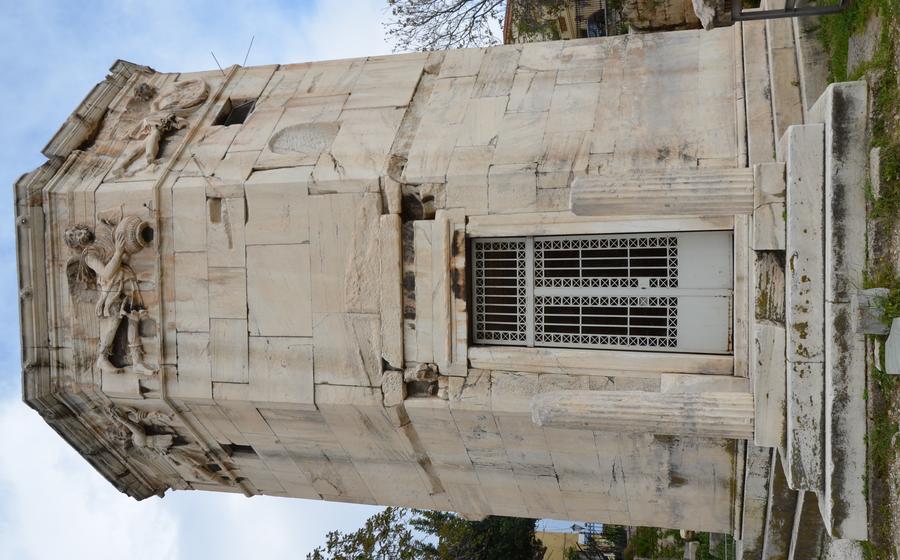
Tower of the Winds
- A Journey Through Time: Unveiling the Tower of the Winds
- Location: A Beacon in the Heart of Athens
- Architecture: A Masterpiece of Ancient Ingenuity
- Horologion: Measuring Time with Precision
- Triton Frieze: Guardians of the Winds
- Anemoi Reliefs: A Symphony of Winds
- Functions of the Tower: Beyond Timekeeping
- Historical Transformations: A Witness to Change
- Current Significance: A Symbol of Athenian Identity
- Visiting the Tower of the Winds: A Traveler's Guide
- Exploring the Neighborhood: Hidden Gems of Athens
- Insider Tips for an Enriching Experience
- Educational Programs and Workshops
- Souvenirs and Mementos: A Piece of the Past
- Insider Tip: Unveiling the Hidden Courtyard
A Journey Through Time: Unveiling the Tower of the Winds
In the heart of Athens, a captivating monument stands as a testament to ancient Greek ingenuity and scientific prowess: the Tower of the Winds. Built in the 1st century BC, this octagonal structure has gracefully withstood the passage of time, showcasing the architectural brilliance and cultural significance that characterized ancient Greece. Its intricate carvings, detailed friezes, and innovative timekeeping mechanisms offer a glimpse into the lives and minds of the people who once called this city home. As you approach the Tower, the intricate details and symbolism etched into its marble facade beckon you to embark on a journey through history, uncovering the secrets held within this architectural masterpiece.
Location: A Beacon in the Heart of Athens
The Tower of the Winds stands tall in the heart of modern Athens, at the junction of Aiolou and Kyrristou streets. Its exact address is Aiolou 2The tower is easily accessible by public transport, with the Thissio metro station just a short walk away. The tower's proximity to other landmarks, such as the Ancient Agora and the Roman Agora, makes it a convenient stop on any historical tour of Athens. The neighborhood surrounding the tower exudes a unique charm, with narrow streets lined with traditional tavernas, cafes, shops, and art galleries. Visitors can immerse themselves in the vibrant energy of this historic district while exploring the Tower of the Winds and its surroundings.
Architecture: A Masterpiece of Ancient Ingenuity
The Tower of the Winds stands as a testament to the architectural prowess of ancient Greece. Its octagonal structure, meticulously crafted from Pentelic marble, showcases the exceptional craftsmanship of the era. The exterior is adorned with intricate friezes and sculptures that depict mythological scenes and personifications of the winds, adding a layer of artistic grandeur to the building's functionality.
The tower's most striking feature is its integration of a sundial and a water clock, demonstrating the ingenuity and scientific advancement of ancient Athenians. The sundial, with its precisely aligned gnomon, allowed for accurate timekeeping based on the sun's position. Meanwhile, the water clock, driven by a clever mechanism that regulated the flow of water, provided a reliable means of measuring time during cloudy or nighttime hours.
The tower's design and construction reflect the convergence of scientific knowledge, artistic expression, and practical utility, making it a masterpiece of ancient Greek architecture and a symbol of Athenian innovation and creativity.
Horologion: Measuring Time with Precision
The Tower of the Winds served as a sophisticated timekeeping device in ancient Athens, embodying the city's fascination with astronomy and horology. Its most remarkable feature was the horologion, a combination of a sundial and a water clock that allowed for precise timekeeping throughout the day and night.
The sundial, positioned on the southern face of the tower, consisted of a gnomon (a pointer) that cast a shadow on the graduated marble surface, indicating the hours. The water clock, located on the northern face, utilized a clever mechanism involving a cistern and a float. As water gradually flowed into the cistern, the float rose, and a pointer attached to the float moved along a scale, indicating the time.
Beyond its practical function, the horologion held great scientific and cultural significance. It enabled astronomers to make precise observations of the sun's position and the movement of stars, contributing to the advancement of ancient astronomy. The intricate mechanism of the water clock showcased the ingenuity of ancient engineers and symbolized Athens's reputation as a center of knowledge and innovation.
The Horologion of the Tower of the Winds stands as a testament to the ancient Greeks' mastery of timekeeping and their enduring fascination with the cosmos. Its precision and beauty continue to captivate visitors, offering a glimpse into the scientific and cultural achievements of this remarkable civilization.
Triton Frieze: Guardians of the Winds
Encircling the upper section of the Tower of the Winds, the Triton Frieze captivates visitors with its intricate carvings depicting the eight wind deities of Greek mythology. These majestic figures, known as the Anemoi, each represent a specific direction and bring to life the forces of nature that shape the world.
-
Boreas, the North Wind, is portrayed as a bearded man with a fierce expression, his cloak billowing behind him, symbolizing the strength and coldness of the northern gales.
-
Zephyrus, the West Wind, is depicted as a gentle youth, his face serene and his hair flowing in the breeze, representing the refreshing and life-giving winds from the west.
-
Notus, the South Wind, is characterized by his plump figure and somber demeanor, embodying the oppressive heat and humidity of the southern winds.
-
Eurus, the East Wind, is depicted as a mature man with a stern countenance, his cloak wrapped tightly around him, representing the unpredictable and often stormy winds from the east.
Each of these wind gods is depicted with distinct attributes and expressions, reflecting their unique characteristics and the diverse forces of nature they represent. The Triton Frieze stands as a testament to the Greeks' deep understanding of the natural world and their ability to translate it into stunning artistic form.
Anemoi Reliefs: A Symphony of Winds
The Tower of the Winds is adorned with a series of exquisite reliefs depicting the eight wind deities, known as the Anemoi. Each wind is personified with unique attributes, reflecting their mythological associations and symbolic meanings.
Boreas, the north wind, is portrayed as a bearded, cloaked figure, his stern expression hinting at his cold and blustery nature. Zephyrus, the west wind, is depicted as a gentle youth, his flowing hair and drapery suggesting his refreshing breeze. Notus, the south wind, appears as a mature man with a stern countenance, embodying his powerful and sometimes destructive nature. Eurus, the east wind, is depicted as a vigorous young man, his outstretched arms symbolizing his invigorating force.
These reliefs are not merely decorative elements but also profound expressions of ancient mythology and symbolism. Each wind deity carries cultural and religious significance, representing different aspects of nature, human behavior, and divine power. The intricate details and artistic craftsmanship of these reliefs invite visitors to delve deeper into the rich tapestry of Greek mythology and its enduring influence on Western culture.
Functions of the Tower: Beyond Timekeeping
While its primary purpose was timekeeping, the Tower of the Winds served various other functions in ancient Athens. It functioned as a meteorological station, enabling observations of weather patterns and wind directions. The intricate carvings on the tower's exterior provided valuable information for sailors, farmers, and travelers, who relied on accurate weather forecasts for their daily activities.
Additionally, the tower served as a center for astronomical studies. Its unique design and orientation allowed ancient astronomers to observe the movements of the sun, moon, and stars, contributing to the development of ancient astronomy and calendar systems.
Beyond its scientific purposes, the Tower of the Winds was also a significant public gathering place. The open space surrounding the tower provided a venue for public meetings, debates, and discussions. Citizens from all walks of life would gather here to engage in political, philosophical, and social discourse, making the tower a hub of intellectual and cultural exchange.
Finally, the Tower of the Winds stood as a testament to Athenian ingenuity and craftsmanship. Its intricate design, exceptional artistry, and innovative mechanisms embodied the city's commitment to knowledge, science, and the pursuit of excellence. The tower served as a symbol of Athenian identity and pride, showcasing the city's cultural achievements and contributions to the ancient world.
Historical Transformations: A Witness to Change
Throughout the centuries, the Tower of the Winds has undergone various transformations, mirroring the changing tides of history. During the Byzantine era, the tower served as a bell tower for a nearby church, showcasing the blending of ancient and Christian traditions. Under Ottoman rule, the tower's significance shifted towards astronomy, as it was used for astrological observations and timekeeping. The 19th century brought about restoration efforts, led by renowned archaeologists, who meticulously preserved the tower's original features and ensured its enduring legacy. Despite these changes, the Tower of the Winds has remained a steadfast symbol of Athenian ingenuity, adapting to the evolving needs of each era while retaining its timeless essence.
Current Significance: A Symbol of Athenian Identity
The Tower of the Winds stands as a testament to the enduring legacy of ancient Athens, recognized by UNESCO as a World Heritage Site for its exceptional cultural and historical value. It is a source of immense pride for the people of Athens, symbolizing the city's rich heritage and architectural prowess. The tower's enduring presence and significance in modern Greek culture are evident in its frequent depiction in art, literature, and even on everyday objects, showcasing its status as a beloved and iconic landmark. Its ongoing fascination and appreciation by both locals and visitors alike solidify its position as a symbol of Athenian identity, a tangible link to the city's glorious past.
Visiting the Tower of the Winds: A Traveler's Guide
The Tower of the Winds is open to the public, offering a unique opportunity to step back in time and immerse oneself in the wonders of ancient Greek ingenuity. Visiting hours typically run from 8:00 AM to 3:00 PM, with admission fees varying depending on the season and any ongoing exhibitions. While self-guided exploration is an option, guided tours are highly recommended to delve deeper into the Tower's history, architecture, and significance. Visitors with disabilities should inquire about accessibility arrangements to ensure a smooth and enjoyable visit.
For photography enthusiasts, the Tower of the Winds presents a treasure trove of captivating angles and details. The intricate carvings, the interplay of light and shadow, and the surrounding cityscape provide ample opportunities to capture stunning images. Tripods and flash photography are generally permitted, allowing visitors to document their experience and share it with the world.
Exploring the Neighborhood: Hidden Gems of Athens
Venturing beyond the Tower of the Winds, visitors will find themselves immersed in the vibrant tapestry of the surrounding neighborhood. A treasure trove of hidden gems awaits those willing to explore. Just a stone's throw away lies the Ancient Agora, a bustling marketplace in ancient times, where visitors can step back in time and witness the remnants of a glorious past. The neighborhood is also dotted with traditional tavernas and cafes, where one can savor the authentic flavors of Greek cuisine and soak in the local atmosphere. For those seeking unique souvenirs, the nearby markets and shops offer an array of handcrafted goods and local delicacies. To fully appreciate the neighborhood's charm, embark on a leisurely walking route that takes you past scenic viewpoints and unveils hidden architectural wonders.
Insider Tips for an Enriching Experience
Timing is crucial for a truly memorable visit to the Tower of the Winds. To avoid the crowds and relish the tranquility of the site, plan your visit for the early morning or late afternoon. This will allow you to fully immerse yourself in the Tower's history and appreciate its intricate details without distractions.
Combine your visit to the Tower with other nearby attractions to create a comprehensive itinerary. The Ancient Agora, with its well-preserved ruins and fascinating stories, is just a stone's throw away. The Roman Agora, Hadrian's Library, and the Temple of Hephaestus are also within easy walking distance, offering a glimpse into Athens' rich past.
Throughout the year, Athens hosts various festivals and events that celebrate the city's heritage and culture. Keep an eye out for events related to the Tower of the Winds, such as guided tours, workshops, and exhibitions. These events provide an opportunity to delve deeper into the Tower's significance and connect with fellow enthusiasts.
Lastly, consider capturing the essence of the Tower through sketching or painting. Set up your easel in the courtyard or find a spot with a view of the Tower and let your creativity flow. This immersive experience will allow you to connect with the Tower on a personal level and create a lasting memory of your visit.
Educational Programs and Workshops
The Tower of the Winds offers a range of educational programs and workshops designed to engage visitors of all ages and backgrounds. These programs aim to promote cultural heritage through interactive and hands-on experiences.
-
School Programs: The Tower collaborates with educational institutions to provide guided tours, workshops, and interactive activities tailored to school curricula. Students can learn about ancient timekeeping, astronomy, and the cultural significance of the Tower.
-
Group Workshops: The Tower also offers workshops for groups and organizations. These workshops can focus on specific aspects of the Tower's history, architecture, or scientific significance. Participants can engage in hands-on activities related to ancient timekeeping techniques and astronomical observations.
-
Family Activities: For families with children, the Tower hosts interactive workshops and activities designed to make learning about ancient history fun and engaging. Kids can participate in storytelling sessions, craft workshops, and hands-on experiments related to the Tower's functions.
-
Cultural Heritage Promotion: Through these educational programs and workshops, the Tower of the Winds plays a vital role in preserving and promoting Greek cultural heritage. Visitors gain a deeper understanding of the ingenuity and scientific advancements of the ancient Greeks, while fostering a sense of appreciation for the Tower's enduring legacy.
Souvenirs and Mementos: A Piece of the Past
A visit to the Tower of the Winds offers a unique opportunity to take home a piece of its rich history and cultural significance. The surrounding area is dotted with shops and stalls selling a variety of souvenirs and mementos inspired by the Tower's design and symbolism. From intricate replicas of the tower itself to handcrafted jewelry featuring wind motifs, there's something for every taste and budget.
Local artisans showcase their skills in creating unique handicrafts and artworks that pay homage to the Tower's significance. These one-of-a-kind pieces, ranging from ceramics and textiles to paintings and sculptures, capture the essence of the Tower and its enduring legacy.
For those seeking a deeper understanding of the Tower's history and significance, a selection of books and publications is available at nearby bookstores and gift shops. These publications provide detailed accounts of the Tower's construction, functions, and cultural impact, offering a lasting reminder of this ancient marvel.
Whether you choose to adorn yourself with wind-inspired jewelry, display a miniature replica of the Tower in your home, or delve into its history through books and publications, these souvenirs serve as tangible mementos of your encounter with this iconic landmark, reminding you of the timeless allure of the Tower of the Winds.
Insider Tip: Unveiling the Hidden Courtyard
Venture beyond the main facade of the Tower of the Winds to discover a hidden gem—a tranquil courtyard nestled within its ancient walls. This serene oasis offers a respite from the bustling city, inviting visitors to pause and reflect amidst historical charm. Surrounded by remnants of the past, the courtyard exudes a palpable sense of tranquility, making it an ideal spot for contemplation and introspection. Whether seeking a moment of solitude or simply appreciating the beauty of this hidden treasure, the courtyard provides a unique and enriching experience that adds depth to any visit to the Tower of the Winds.
